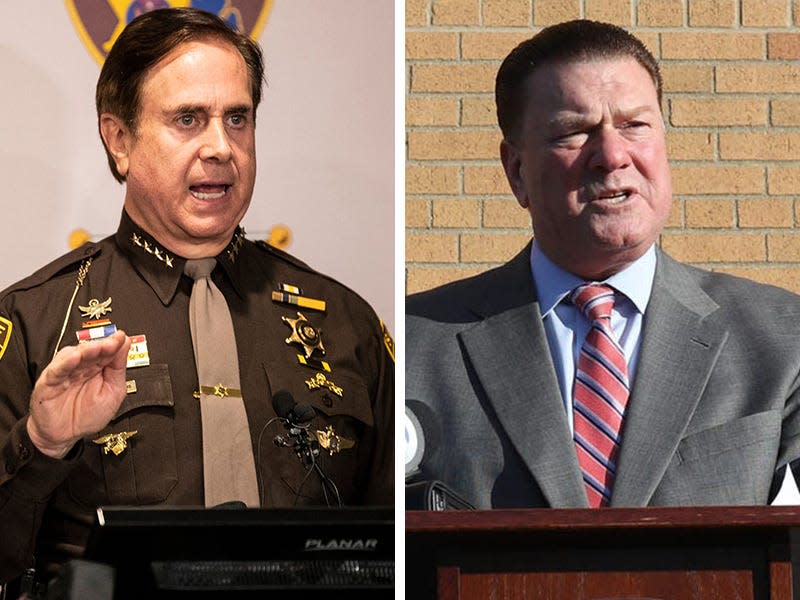Opinion: Prosecuting copycat school threats feels reassuring — but reveals another problem
A rash of threats against schools around the country followed hard on the heels of the tragic mass shooting last month at Oxford High School. Numerous arrests followed.
The individuals arrested have been charged under a variety of statutes that punish what the law calls “true threats.” We might find these prosecutions reassuring. But the growth of the law around true threats carries an ominous significance and tells a deeply worrisome cautionary tale.

The story of true threat jurisprudence begins Aug. 27, 1966. On that date, 18-year-old Robert Watts was attending a protest in Washington, D.C.
Watts had recently received a draft notice that ordered him to appear the coming Monday for a physical exam, and he was angry about it. A federal investigator on the scene overheard Watts say: “I am not going. If they ever make me carry a rifle, the first person I want to get in my sights is LBJ.”
Watts was arrested, charged under a federal law that makes it a felony to threaten the life of the president and convicted. The appellate court affirmed his conviction.
More: St. Clair Shores middle school staff member arrested, accused of leaving threatening note
More: Copycat threats after Oxford school shooting leave juveniles facing drastic consequences
These courts followed a straightforward line of reasoning: Threatening the life of the president is serious stuff; Watts had talked about aiming a rifle at President Lyndon Johnson; therefore, he was guilty as charged.
Watts appealed to the Supreme Court of the United States, which reversed his conviction. Justices acknowledged that the federal statute addressed important concerns and was valid on its face.
The high court concluded, however, that the speech at issue did not rise to the level of a true threat. Watts was simply engaging in political hyperbole, which the First Amendment protects.
Intimidation or exaggeration?
The majority that overturned Watts' conviction provided few clues about what might qualify as a true threat. For several decades, the Supreme Court did nothing to clarify matters.
In the last 20 years, though, the court has offered additional guidance.
A 2003 case involved prosecutions under a statute that prohibited cross burning done with the intent to intimidate. The Supreme Court explained that true threats encompass those expressions “where the speaker means to communicate a serious expression of an intent to commit an act of unlawful violence to a particular individual or group of individuals.”
In a 2014 case, a man was prosecuted for posting on social media threats against his wife, his coworkers and a kindergarten class, among others. The court held that it was not enough that a hypothetical reasonable speaker would have understood the speech as threatening. The actual speaker must have subjectively intended it as such.
These Supreme Court decisions leave open many questions that the lower courts have labored to answer. The doctrine of true threats has evolved and expanded. We have more law on this issue than ever before.
We might feel tempted to count these developments as progress, but that would be a mistake. We have more law about threats because we need it, just as we need more law to keep guns out of the hands of murderers, a project at which our current law is failing spectacularly. Eventually, we will probably get it, and we will count it as progress when we do.
Enforcing decency
But this assessment misses the bigger picture. Every additional law of this nature reflects a moral failure on our part. A failure to be good without coercion. A failure to be responsible without the promise of punishment. A failure to be decent without a brandished stick.
The legal scholar Grant Gilmore maintained that a truly good society does not need much law. He wrote: “The better the society, the less law there will be. In Heaven there will be no law and the lion will lie down with the lamb.”
In contrast, he said, “the worse the society, the more law there will be.” And “in hell,” he concluded, “there will be nothing but law.”
To the extent they are successful, the prosecutions of those who have made threats against schools might make us feel good about how our society is working. We might count them as wins.
Gilmore argues for a different conclusion.
He suggests that when we need more law to deal with cross burning, with online cries for violence and with threats made against children sitting in classrooms, something has gone seriously wrong.
Indeed, it has. And by itself the law has little chance of fixing it.
Len Niehoff is a professor at the University of Michigan Law School.

This article originally appeared on Detroit Free Press: Opinion: Prosecuting copycat school threats is ominous sign

